LESSONS FROM COVID-19 LOCKDOWNS WITH RASPBERRY SHAKES
January 18, 2021 – Written by Alan Kafka, Weston Observatory, Boston College
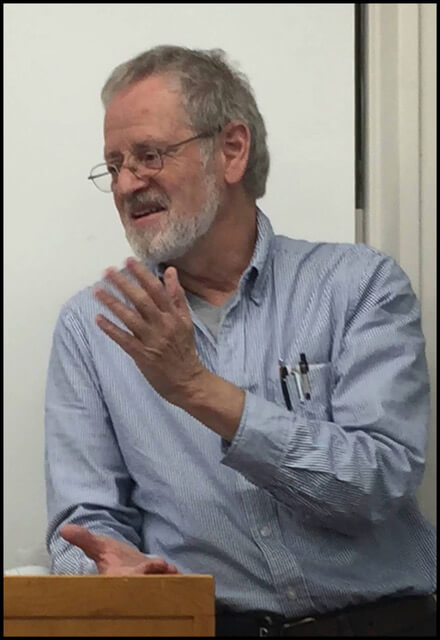
Alan Kafka’s research and teaching interests span the intersection of geophysics, earthquake science, environmental systems, and citizen science for the public good. He studies earthquakes and seismological processes in many regions of planet Earth, and has long been obsessed with the enigma of why earthquakes occur in the Eastern U.S., deep in the interior of the North American plate. Alan is inspired by and active in promoting today’s new technologies that drive emerging opportunities for cooperation among seismologists and students of all backgrounds and ages around the world. His home base is the Department of Earth and Environmental Sciences at Boston College, and he is Director of BC’s Weston Observatory, a geophysical research and science education center.
INTRODUCTION
The COVID-19 saga began about a year ago and has upended “normal life” for virtually everyone on planet Earth. While a challenging experience for me personally, the pandemic has also been a time of unexpected new directions in my research and teaching. Raspberry Shake seismographs played a major role in that story.
Pandemic restrictions motivated me, and many other scientists and academics, to experiment with new approaches to research and teaching. In my case, my research and teaching was notably affected by my involvement in a study of seismic quieting associated with lower levels of human activity brought about by COVID-19 lockdowns (Figure 1). My participation in that study, which relied heavily on Raspberry Shake data, launched me into an adventure that resulted in a paper (published with 76 co-authors from around the world) about this seismic quieting (Lecocq, et al., 2020). My involvement in that study was also significant in my approach to teaching during COVID-19, making all of this much more of a teaching/research synergism than I could have imagined just a year ago.
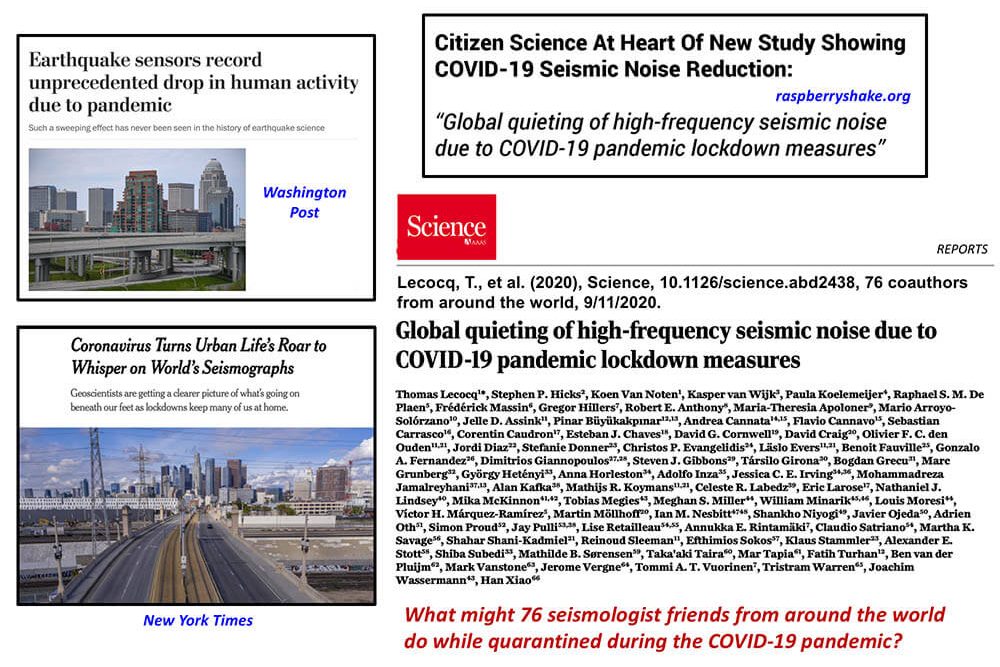
Figure 1: Thomas Lecocq and 75 seismologist colleagues from around the world, analyzed hundreds of global stations in their study of COVID-19 seismic noise reduction. About ¼ of those were Raspberry Shake sites. They made use of citizen seismographs in noisy locations to complement other research seismographs in a study of changes in human activity around the world due to COVID-19 lockdowns. When the lockdowns were imposed there was a drop in human activity such as walking, driving, and use of public transportation, resulting in a decrease in ways that humans create seismic vibrations of the Earth. Lecocq et al. (2020) were thus able—with the help of Raspberry Shakes—to quantify the decrease in global human activity due to the pandemic lockdowns.
ADVENTURES IN TEACHING AND RESEARCH DURING COVID-19 LOCKDOWNS
In two of my courses—Geoscience and Public Policy, and Environmental Systems: The Human Footprint—we cover the intersection of Earth systems and society. Students taking those courses in the spring of 2020 had a very immediate, personal experience of that intersection. We were faced with the very stressful situation of being told we must immediately leave the campus for the rest of the semester and abruptly switch to online learning. But through this unexpected event, we also experienced a “teachable moment” regarding how humans interact with global Earth processes in ways that can have direct effects on our lives. Although very stressful for all involved, the situation motivated the addition of a new topic for both courses: the intersection of global Earth systems, human population dynamics, and the spread of COVID-19.
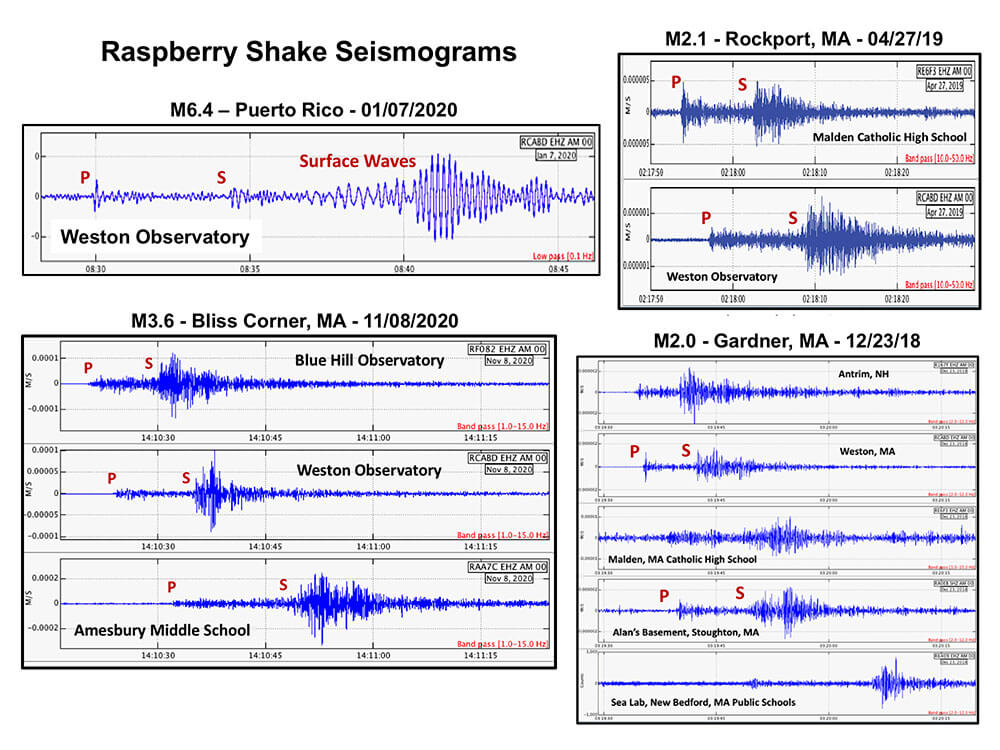
Figure 2: New England earthquakes that were regionally-recorded at Raspberry Shake citizen seismograph sites in the Boston area, and the magnitude 6.4 earthquake in Puerto Rico (also recorded by a Shake in New England).
While all of that was happening in my teaching, a parallel story was unfolding in my work at Weston Observatory. The observatory monitors earthquakes around the world, and that includes a “seismographs for citizens of planet Earth” project in which we operate low-cost seismographs (now primarily Raspberry Shakes) in schools and other public and private places (Figures 2 and 3). Our earthquake monitoring, our citizen seismology initiative, and my experience of the abrupt transition to online teaching all converged in my involvement in the global quieting study.
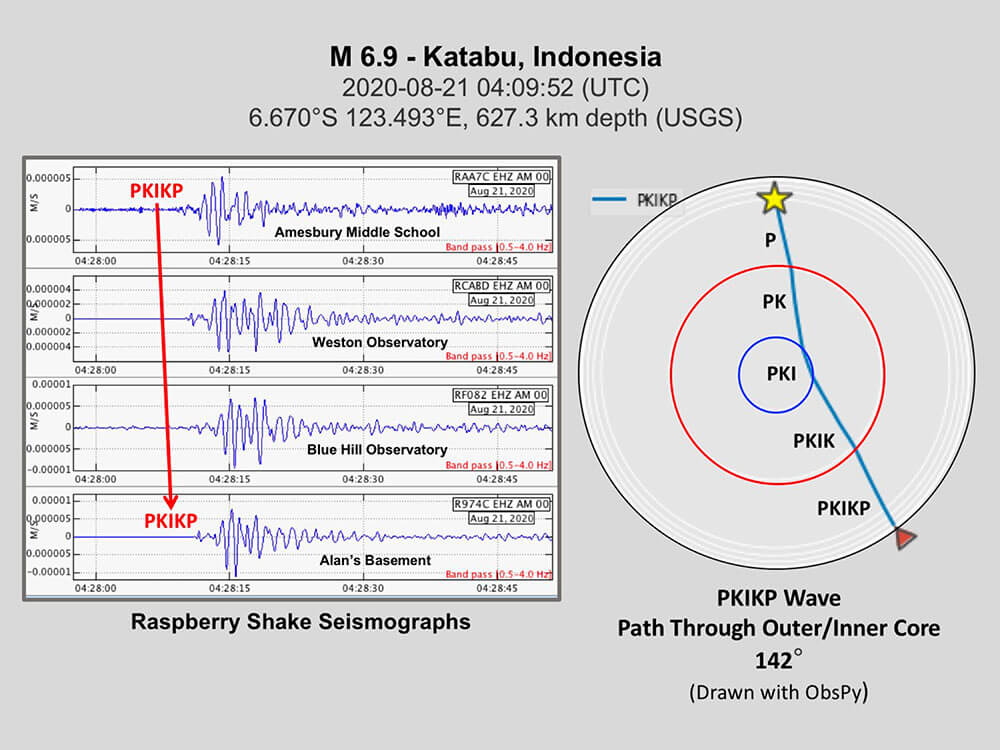
Figure 3: Four seismograms recorded by Raspberry Shakes at citizen seismograph sites in the Boston area from a magnitude 6.9 earthquake in Indonesia. These recordings are of a seismic wave called “PKIKP”, which penetrates deep within the Earth’s outer and inner core and arrives, well-recorded, at the Raspberry Shake sites.
So, what is this “seismic hush” all about? While adjusting to life in the new pandemic lockdowns, and working mostly online, many seismologists around the world observed a global quieting of seismic noise corresponding in time to the pandemic lockdowns. I observed it in New England, and specifically at two of the Shakes I operate on the Boston College (BC) campus (RA2DE, in the student athletics center, and R57EC, in the building where my courses are taught). Thomas Lecocq (of the Royal Observatory of Belgium) began reporting on the seismic hush he was seeing in Belgium and inspiring other seismologists to get involved with studying that phenomenon at other locations around the world using his open source software. He posted his seismic noise analysis code on the internet, which enabled me to replicate the same processing algorithm that he (and by then a growing number of other seismology colleagues) were using.
In both courses it was time for my usual topic of earthquakes, the environment, and the challenge of living on an active planet. This is when I typically discuss seismology, seismographs, citizen seismology, and Weston Observatory’s role in monitoring how the Earth quakes. This year, my students were able to directly experience scientists recording and analyzing the global seismic hush on a seismograph in the same building where their courses are taught! My students could thus see the science unfolding right in their classroom at the same time they were seeing it unfold in the media. And because of the Shake community’s well-established culture of social networking and citizen science technology, it didn’t matter that much that the students were no longer present in the classroom. I could include the students in my emails describing the phenomenon, and they could see my Twitter and Weston Observatory announcements in which I was describing our latest observations on our Shakes at BC to the public and the research community. Teaching these courses became additional motivation for my participation in this research project, and the project was developing in such a way that I could bring up-to-date research into the course experience.
“NOISY” CITIZEN SEISMOGRAPH SITES HELP TRACK EFFECTS OF LOCKDOWNS
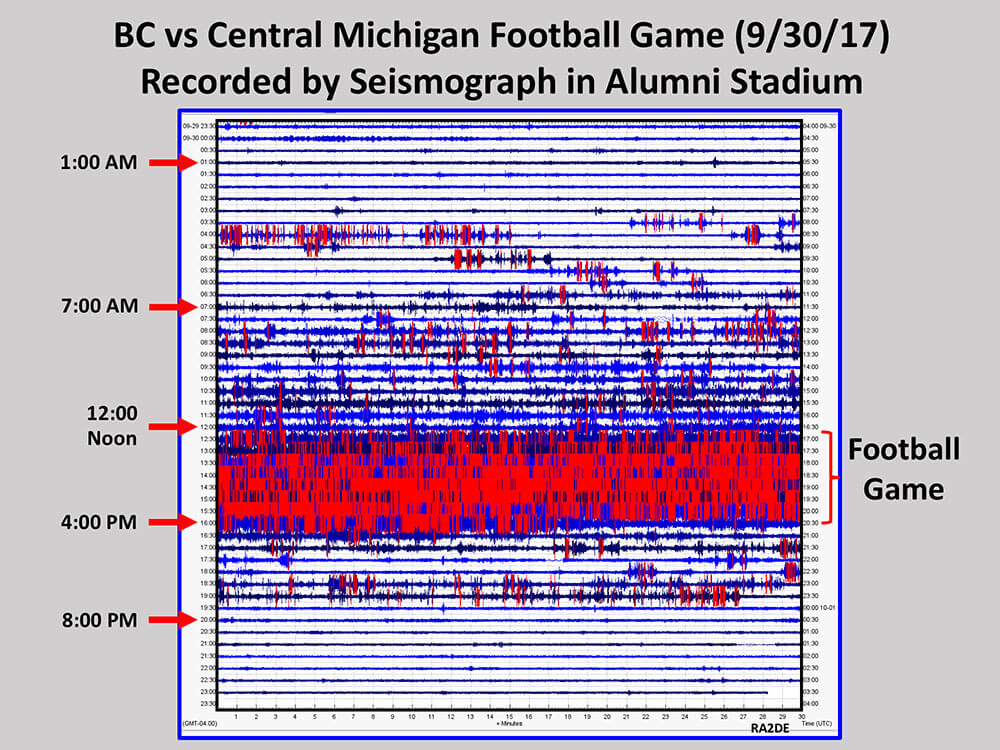
Figure 4: Raspberry Shake recording of a Boston College football game.
We usually think of seismographs as recording earthquakes, which of course they do, but they also record lots of other things that “shake”, such as athletic events (Figure 4), activities of people near the seismograph (Figure 5), and vehicle traffic near the site. In the case of typical research seismographs, we try to install them (to whatever extent possible) in seismically quiet places so that earthquake signals won’t be obscured by signals from other sources of seismic waves. Citizen seismographs, by contrast, can be quite noisy because they are often purposely installed near people and other human cultural noise sources. We want our citizen seismographs to be near where the people are. That can be a problem for seismic monitoring of earthquakes, but it’s not always bad for other aspects of seismology.
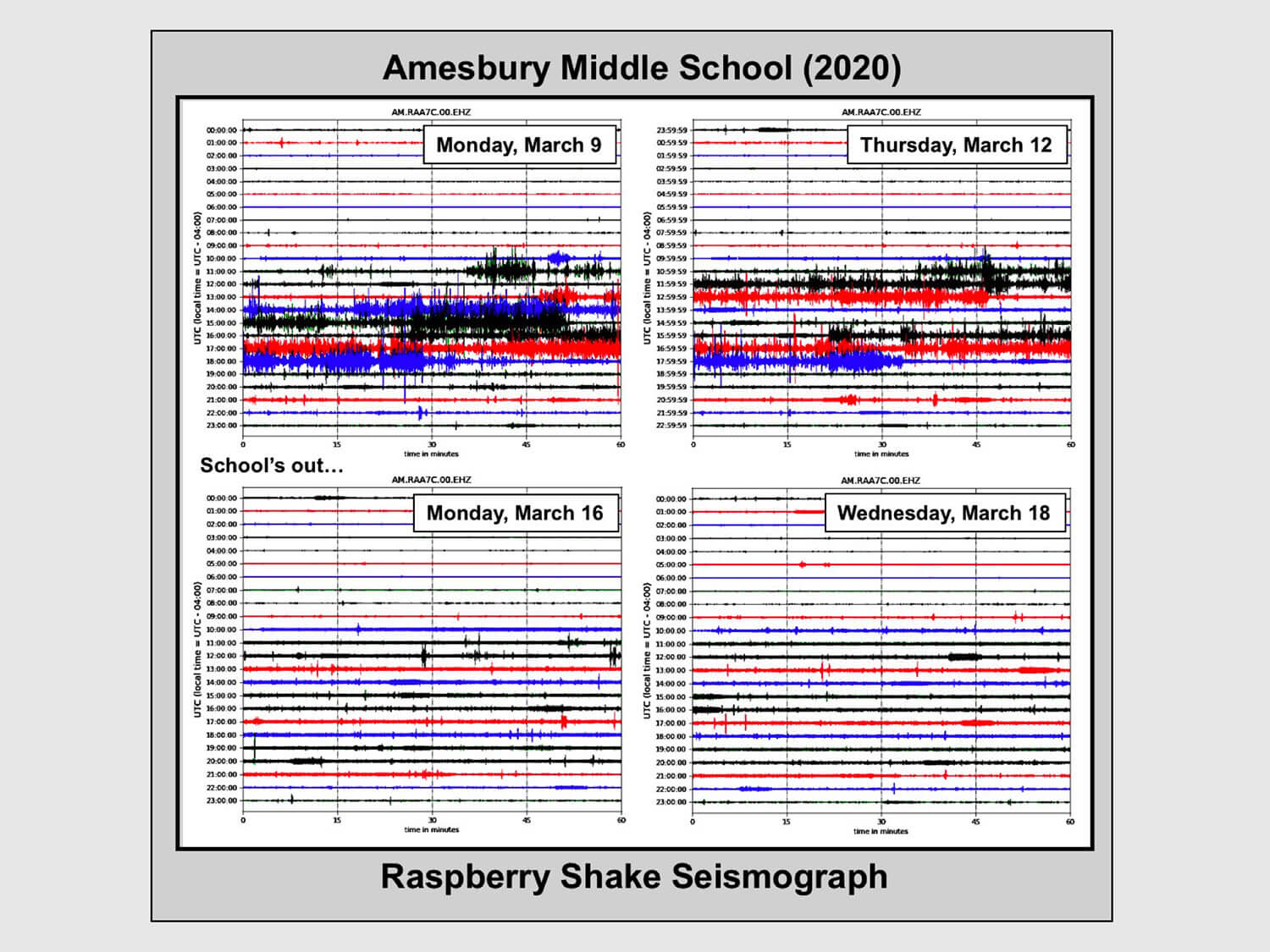
Figure 5: Four days of recording at Amesbury (MA) Middle School. Top row is the two of the days before the COVID-19 lockdown at the school, and bottom row is two of the days after the lockdown. The effect of students in the classroom during the two days before lockdown, and the quieting afterward, is clearly observed.
At schools we usually put the seismographs in classrooms or other locations where there are a lot of students, so the school seismographs are usually noisy. But these noisy sites turned out to be just the right settings for seeing the effects of the pandemic lockdowns. Shortly before the lockdowns, I had installed a Shake at Amesbury MA Middle School (in a classroom with many students). I recognized the downside of having the seismograph right in the classroom, but it was also valuable for the students to be directly involved with the seismograph and what it’s recording. When Amesbury Middle School was locked down, the seismic noise quieting effect was very clearly observed there (Figures 5 and 6).
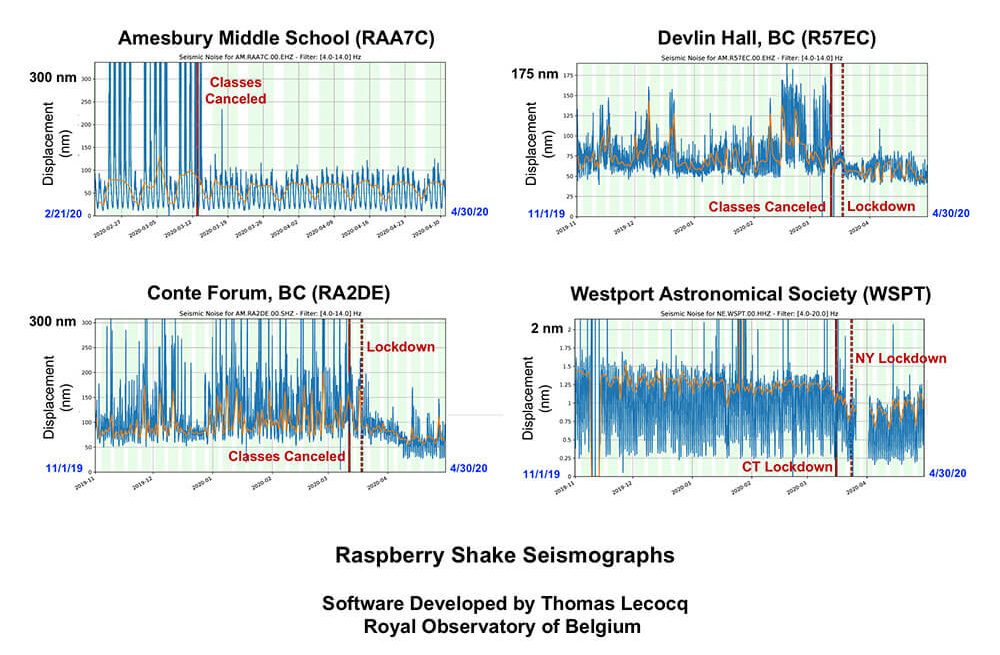
Figure 6: Examples of seismic noise analysis using the open source computer code provided by Thomas Lecocq: Amesbury Middle School and Devlin Hall & Conte Forum at BC are Shake data. The seismograph at Westport Astronomical Society (located in a Connecticut suburb of the New York City metropolitan area) is a much more expensive “research-grade” seismograph (part of Weston Observatory’s New England Seismic Network). The seismic quieting after lockdown times is clearly observed.
CITIZEN SEISMOGRAPHS ENRICH THE STUDY OF HUMAN ACTIVITY DURING THE PANDEMIC LOCKDOWNS
When the COVID-19 lockdowns were imposed, leading to the drop in human activity (such as walking, driving, and use of public transportation), that meant there was a drop in the ways that humans create seismic vibrations of the Earth. The global team of 76 seismologists were thus able, with the help of Raspberry Shake seismographs, to quantify the decrease in global human activity due to the pandemic. A global summary of the observations of the seismic quieting, and its relationship to the lower levels of human activity, is presented in Lecocq et al., Global quieting of high-frequency seismic noise due to COVID-19 pandemic lockdown measures (2020).
The study was based on analysis of hundreds of global seismograph stations, and about ¼ of those seismographs were Raspberry Shakes. So, in addition to the basic research dimension of this study, it was also a good example of how low-cost citizen seismographs can contribute to a real science research project. And the value of citizen seismology was highlighted by the fact that so many of the seismographs used in the study were Shakes located at schools and other citizen seismology sites.
DISAMBIGUATING LOCAL VS. REGIONAL VS. GLOBAL SOURCES OF SEISMIC NOISE
In addition to our study of seismic noise on the BC campus, my colleague Jay Pulli and I are studying seismic noise recorded by a Shake (RAC22) at a suburban site near Washington, DC (Pulli and Kafka, 2020). Figure 7 shows seismic noise at the BC and DC sites, along with variation of human activity before and after the imposed lockdowns (depicted by human activity data from apple.com/covid19/mobility). The next phase of our research involves untangling specific local effects of COVID lockdowns from the mixture of regional and global patterns. Broad trends of the noise data generally correlate with the mobility data, which reflect activity over the larger Boston and DC regions, but that broad pattern is undoubtedly mixed with noise from nearby sources. We are exploring the extent to which the fluctuations around those broad trends seen in Figure 7 can be explained by differences in nearby sources superposed on the regional and global effects. For example, the Conte Forum BC athletics center is nearer to commuter and campus vehicle traffic than Devlin Hall.
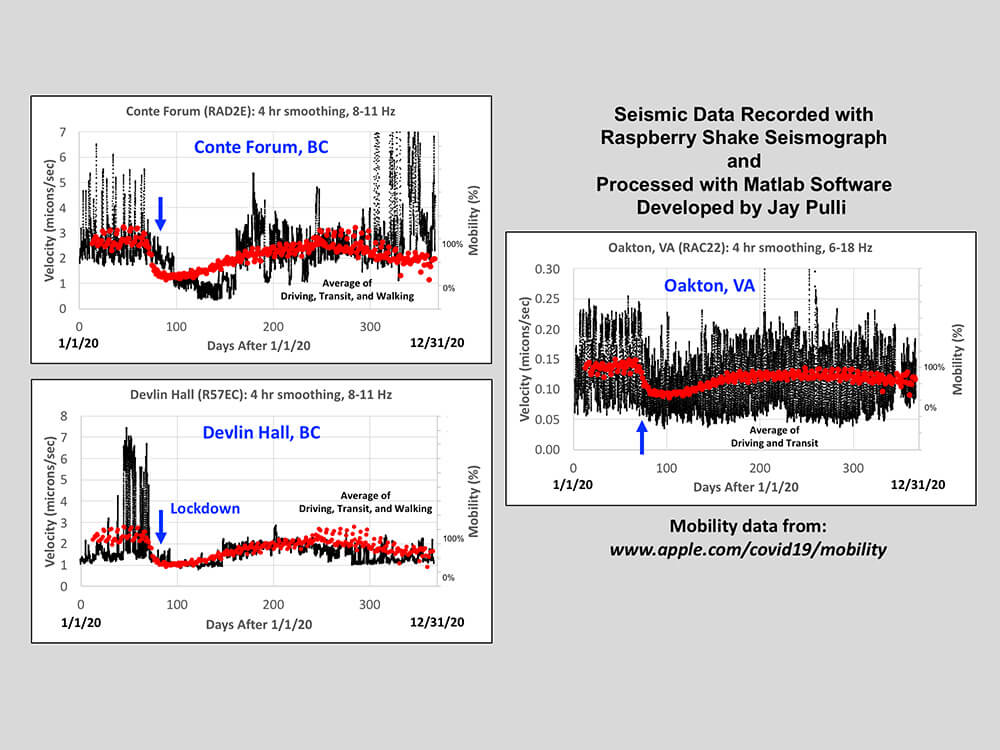
Figure 7: Latest results showing details of the fluctuation of seismic noise (black) along with mobility data (red) for: Conte Forum and Devlin Hall at BC, and for the suburban Washington, DC site (Oakton, VA). The seismic quieting after lockdown times, and evidence of a return to higher levels of human activity in more recent months, are clearly observed.
Pulli and Kafka (2020) also applied a model of vehicle traffic noise from nearby roads to explore the pattern observed at the DC site. In that study, traffic noise was modeled to estimate the expected noise level from traffic on roads near the site. We also plan to apply that model to the BC data, modeling the effects of traffic around the BC campus and other possible noise sources.
“SOCIAL SEISMOLOGY” AND NEW WAYS TO MAKE SCIENCE MORE APPROACHABLE TO A WIDER AUDIENCE
This new area of research that I have been fortunate to be involved in is part of what we are now referring to as “Social Seismology”, which provides citizen scientists with a new way of seeing how much humans affect planet Earth. With a Raspberry Shake seismograph, you can see your own personal effects on local, regional, and global seismic monitoring. Social Seismology also highlights new ways for scientists to use social networking and internet technology to connect with each other and to connect with a more public audience, making science more approachable for a wider audience.
Nobody expected the pandemic to be such a major part of all aspects of our lives, including a wide range of science research, and specifically seismology. Through a series of events that nobody involved could have imagined, low-cost Raspberry Shake citizen seismographs have been shown to be useful as an integral part of basic research.
And that’s how Raspberry Shakes linked seismic moments with teachable moments during COVID-19 lockdowns.
REFERENCES AND FURTHER READING:
Kafka, A.L., and J.J. Pulli (2020), The COVID-19 Seismic Noise Quiet as Seen by Two Raspberry Shake Seismographs Located at Boston College, Fall 2020 Meeting of American Geophysical Union, “Online Everywhere”, December 1-17, 2020 (Abstract).
Kafka, A.L. (2021). “Blog book” for Geoscience and Public Policy course, sites.google.com/bc.edu/geoscience-public-policy-v3/home
Lecocq, T., et al. (2020, including 75 coauthors, see Figure 1). Global Quieting of High-Frequency Seismic Noise Due to COVID-19 Pandemic Lockdown Measures, Science, 10.1126/science.abd2438.
New York Times article (2020). Coronavirus Turns Urban Life’s Roar to Whisper on World’s Seismographs, https://www.nytimes.com/2020/04/08/science/seismographs-lockdown-coronavirus.html
Pulli, J.J., and A.L. Kafka (2020), Decrease in High-Frequency Background Seismic Noise after the COVID-19 Lockdown at a Suburban Site Outside Washington DC, Fall 2020 Meeting of American Geophysical Union, “Online Everywhere”, December 1-17, 2020 (Abstract).
RaspberryShake.org (2020). Citizen Science at Heart of New Study Showing COVID-19 Seismic Noise Reduction, raspberryshake.org/citizen-science-at-heart-of-new-study- showing-covid-19-seismic-noise-reduction/
Tripathy-Lang, A. (2020), As the World Quieted Down in 2020, Raspberry Shakes Listened, arstechnica.com/science/2020/12/as-the-world-quieted-down-in-2020-raspberry-shakes-listened/
Washington Post article (2020). Earthquake sensors record unprecedented drop in human activity due to pandemic, www.washingtonpost.com/science/2020/07/23/human-seismic-noise-coronavirus
From all of us at Raspberry Shake we would like to say a big thank you to Alan Kafka for sharing details of his fascinating observations.